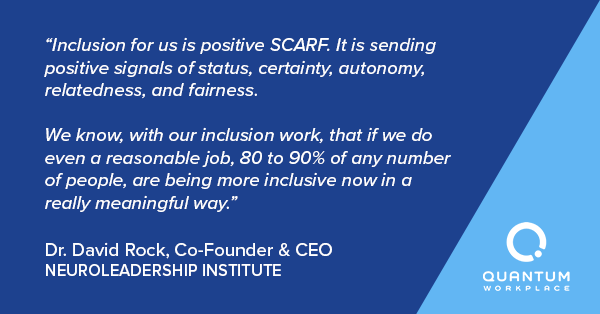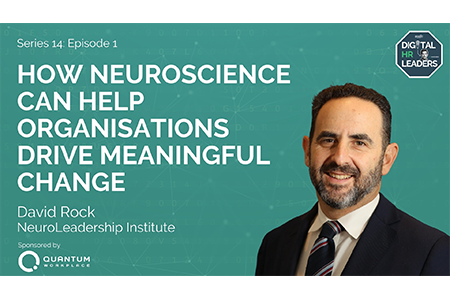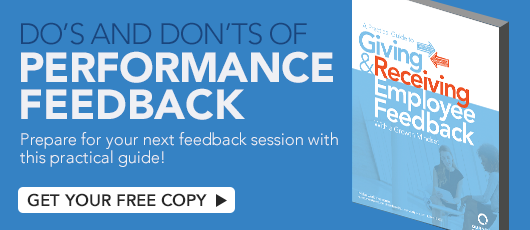Using the SCARF Coaching Model to Drive Engagement and Performance
When we encounter something new, our brain seeks to minimize danger and maximize reward. By becoming more self-aware and understanding these reactions, we can proactively prevent, control, and shift our threat response to a reward response.
What if you could apply this concept of NeuroLeadership within your organization? How would your team or business change if your employees felt more empowered, supported, and included?
In this blog, we share insights from this episode of the Digital HR Leaders podcast—featuring David Green, Director of Insight222 and Dr. David Rock, Co-founder and CEO of the NeuroLeadership Institute.
We cover how the SCARF model can be used to help your employees succeed, including:
- What is the SCARF model
- How is the SCARF model relevant today
- How to enable your organization to leverage SCARF
- The relationship between SCARF and employee engagement
- How to use SCARF to level up your performance management process
What is the SCARF model?
David Rock’s leading research on the social nature of the brain has found that social situations can trigger a positive or negative response. Specifically, our perception of five qualities activates either a threat or reward response. This is known as the SCARF model:
- Status
- Certainty
- Autonomy
- Relatedness
- Fairness
According to Rock, SCARF is disruptive language. He says, "Disruptive language is something that you don't have to work to remember, it just pops into your consciousness in relevant moments, it is disruptive in that sense. So once you learn it, you can't unlearn it and it shows up everywhere."
SCARF describes:
- Why people are reacting (emotionally or positively)
- Why they are motivated or de-motivated
- What is going on as we interact
Status
Your brain is constantly detecting your status compared to other people’s. In other words, status is a sociometric that determines where you are in relation to the people around you. In every interaction, we immediately, automatically, unconsciously, try to work out our status and theirs and we are uncomfortable until it is resolved.
The brain naturally knows our status in every community, including:
- What’s our status?
- Who must we pay attention to?
- Who must pay attention to us?
In the workplace, for example, the CEO is the highest possible status in an organization. Employees, especially managers, strive to obtain status by performing and avoiding mistakes. Status drives our behavior all the time. Bottom line, status is relevant to every interaction we have with everyone.
Certainty
The second quality is certainty—our ability to predict what is going to happen, moment to moment. All our actions are based on predictions, past experiences, and the probability of what’s happening.
When things become uncertain, you get anxious, which can cause a strong, negative response. On the flip side, giving people certainty, like answering questions, removing ambiguity, and setting expectations can activate a positive, reward response.
Autonomy
Autonomy is having a sense of control and that you have choices or options. Often, when something is stressful it’s because we have unconsciously decided that we don’t have control and don’t know what to do. However, when we realize there’s an aspect we can control, it becomes more manageable.
Your autonomy might decrease when your manager tells you do something right now, in this exact way. On the other hand, when your manager gives you 3 different ways to choose from to complete a task, your autonomy might increase. Even though your manager has been prescriptive, you have still got a greater sense of control than you expected.
Relatedness
Relatedness is having an experience of being in an “in-group” with people. This happens when people have similar knowledge, experiences, shared understanding, and aligned goals. When you both are trying to work towards something together, it doesn't matter how different you are. When you create an in-group, you create relatedness.
Fairness
Fairness is something that we read directly. Fairness matters a lot. It’s not only in legal issues, but it also shows up in politics, our social interactions, and in business. We are constantly tracking degrees of fairness.
Essentially, these domains are the things the brain feels passionately about. Avoiding negatives and obtaining positives is the overall architecture that drives our behavior.
How is the SCARF model relevant today?
At the start of the COVID-19 pandemic, there was a huge drop in certainty, autonomy, and relatedness. People lost their sense of control and were disconnected from all the people that normally help them stay calm.
Humans needed a lot of help and companies were wanting to do things to help their people survive and thrive.
The transition to remote work, safety precautions, and more made people put “buffers” in place to combat drops in these qualities. To navigate these drops, organizations can send positive SCARF signals.
| Quality | Experience | Positive SCARF Signals |
| Status | Feeling like a beginner in the world of technology | Celebrate quick wins in unique and creative ways |
| Certainty | Creating a “workable” home office | Improve clarity through frequent, transparent communication |
| Autonomy | Gaining a sense of control over a daily routine | Allowing employees to control where, when, and how they work |
| Relatedness | Losing a corner office (or an office altogether) | Make informative, data-driven decisions about your hybrid strategy |
| Fairness | Working at home and managing children/family schedules | Adopt a “video-on” culture to show the humanness of work |
How to enable your organization to leverage SCARF
When all five domains are in a threat, your response is deeply impacted. Fortunately, you can use SCARF as a tool to help you improve the quality of your interactions among employees and minimize threat.
So how do you scale this model across your organization? Here are a few tips for leaders, managers, and HR.
Leaders
During the pandemic, leaders and individual contributors had shared goals—like balancing remote work and family. This helped leaders appear more human, and as a result humanity became much more acceptable. But this change happened almost by force.
When it comes to more typical change management, most organizations believe that leaders need to understand and cascade a plan first to change culture. But leaders are often fixed in their own ways and tough to crack.
While leaders need to be involved and engaged in most change initiatives, consider the use of upward pressure through your managers and fellow HR team members.
Managers
One of the biggest variables in employee engagement and performance is the relationship between an employee and their manager. If managers make your employees feel uncertain, unsafe, or micromanaged it becomes a real issue. Bottom line–your managers are the key to applying upward pressure.
Consider this—If you were to coach 1,000 managers all at once how to be more inclusive within their teams, you’ll begin to see real change. Managers will escalate issues to senior leadership, and in the meantime begin to act on this information within their teams.

HR Leaders
To build a better normal at work, HR leaders need to educate people leaders at all levels about how to interact with humans more effectively. While many organizations have put a lot of effort into leveraging the right tools to improve engagement, you can’t take the human out of our interactions.
Use the SCARF model to anticipate potential threats, increase opportunities for reward, and ultimately boost engagement.
The relationship between SCARF and employee engagement
One of the powerful things about SCARF is that you can see in real time. During and after an interaction, you can predict what might go wrong, label it, and adjust.
"You can actually think about any kind of interaction at any scale through the lens of SCARF and ahead of time improve it because in almost every situation, less threat and more reward is better."
- Dr. David Rock, Co-Founder and CEO of the NeuroLeadership Institute
Employee engagement happens when employees get smarter about their work, become more certain, have more control, are treated fairly, and work with others build good things together.
SCARF gives you a language to increase engagement by:
- Reducing unnecessary noise to boost certainty
- Inspiring creativity through increased autonomy
- Creating positive interactions through fair experiences
How to use SCARF to level up your performance management process
Engagement is positive SCARF in many ways. When positive interactions increase, people are more open-minded, insightful, creative, and they absorb meaningful information that allows them to perform better in their roles.
Yet many organizations struggle to adapt to continuous performance management frameworks. In fact, some companies were forced to get rid of annual goals amid the pandemic and many returned to frequent, stand-up meetings to discuss weekly task progress.
While this is good news for employees, it’s important to consider how the SCARF management model can boost your performance management process.
Performance management should be less about management, and more about:
- Creating clarity
- Striving for excellence
- Asking for feedback
- Generating insight
- Developing your team
Here are a few ways you can move to a more continuous performance management process in the future:
Define performance.
People leaders need to understand what good performance looks like so that people have more certainty, autonomy, and relatedness with shared goals and expectations.
Ask for critical feedback.
Research shows that asking for feedback should be the driver of performance, not giving feedback. Coach employees to ask for feedback and managers to ask their team members for feedback in return to build trust, reduce stress, and improve honest and accurate feedback.
Adopt a growth mindset.
Growth is all about helping employees get better. Rather than pushing people to try to look good, find out how you can continually help them improve and focus on progress.
These three things are super important in next generation performance management. As you can see, rooting your employee engagement, performance, and development initiatives in the SCARF model can help you greatly impact the success of your employees, teams, and business.
The SCARF model is an essential tool for HR and managers. Get started using the SCARF model in performance feedback with our Practical Guide to Giving and Receiving Feedback.








